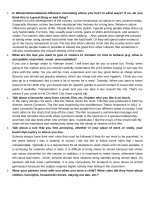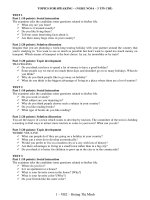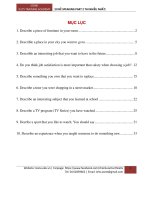2008 12 10 Topic Speaking: aboriginal cricketer
Bạn đang xem bản rút gọn của tài liệu. Xem và tải ngay bản đầy đủ của tài liệu tại đây (65.97 KB, 4 trang )
BBC Learning English
6 Minute English
Aboriginal Cricketer
Yvonne:
Hello - this is '6 minute English' and I'm Yvonne Archer. And with me today is
the lovely William Kremer. Hello William!
William:
Oh hello Yvonne!
Yvonne:
Today – a sporting programme as we hear the story of an extraordinary
Australian cricketer. Sadly, he's only just been recognised - thirty years after
his death. But before we find out more, let's get out today's big question!
William, cricket balls have been made from the same materials since the 1700s.
But what colour were they originally?
a) white
b) light brown or
c) cherry red
William:
Err… as always, I don't know but I'm gonna go for b) light brown because cricket balls are made from leather and lots of leather things are light brown.
So that's my guess – light brown.
Yvonne:
Great answer, but are you right or wrong? We'll find out later on. But now,
let's look at some of the language we'll hear in today's report. First, William what is meant by 'indigenous Australians'?
William:
Well, 'indigenous' people are the original people or native people of a country
or land. So 'indigenous Australians' – who are also known as aboriginals or
aborigines – have always been in Australia. And they were there thousands of
years before Europeans arrived.
6 Minute English
© bbclearningenglish.com 2008
Page 1 of 4
Yvonne:
Can you explain 'indignities'…
William:
Yes, 'an indignity' is something that makes us feel embarrassed or humiliates
us and (makes us feel) of little importance. So to give you an example:
prisoners usually have to shower in front of everyone else – and that's one of
the 'indignities' that they have to live with.
Yvonne:
And 'slights' or 'a slight' – what's that?
William:
'A slight' is a bit of an old fashioned word and it means a quiet kind of insult.
So, if I give you an example: if I say hello to you Yvonne and you turn your
back and start talking to someone else, well that's a bit of a slight – and in fact,
I can say that you've 'slighted' me.
Yvonne:
But of course, I'd never slight you, William. Now in today's report from the
BBC's Nick Bryant, we'll hear about a very talented Australian cricketer who
played many years ago. As you listen, try to find out what two things he
usually needed before he could go and play against white cricketers…
NICK BRYANT
Eddie Gilbert played in the 1930s, when indigenous Australians were confronted with all
kinds of indignities and slights. Even to make the journey to play cricket against white players,
he needed written permission to leave his Aboriginal settlement and was normally chaperoned.
Yvonne:
William, what two things did Eddie Gilbert need as an aboriginal cricketer
before he could go and play against white cricketers?
6 Minute English
© bbclearningenglish.com 2008
Page 2 of 4
William:
Well, he needed to have something in writing – he needed 'written permission'
to say that he was allowed to travel to the cricket match. And he was usually
'chaperoned' – so someone with authority had to go with Eddie even though he
was an adult. And so in Eddie's case, the chaperone would have been a white
man.
Yvonne:
As we heard, aborigines like Eddie, lived in 'settlements' – areas where they
were forced to stay by the Australian government of the time. But Australian
aborigines during the 1930s were demanding equal rights and to be treated
with dignity.
Now Eddie once bowled and hit the bat right out of the hands of one of the
world's best cricketers - Sir Donald Bradman. So Eddie was the fastest bowler
of the era, but as we'll hear, he never entered the 'pantheon of cricket'. William,
can you explain that term for us?
William:
Yes, 'a pantheon' here refers to a special group made up of the world's best
cricketers in this example. And Eddie was never included in that 'pantheon' –
that group of admired and honoured cricketers.
Yvonne:
Yeah - it's believed that Eddie's many years of throwing a boomerang – an
Australian type of hunting weapon – was the reason why he could bowl so fast.
And there's another story about Eddie's skills but it might not be true...
NICK BRYANT
Had Eddie Gilbert been born white, he might well have entered the pantheon of cricket but he
never represented his nation. Folklore has it that one of his deliveries burst through a picket
fence and struck a dog with such force that the animal was killed.
William:
6 Minute English
Oh no – that poor dog!
© bbclearningenglish.com 2008
Page 3 of 4
Yvonne:
Yes, but remember William, it's only folklore so perhaps the story about the
dog isn't actually true. But thirty years after his death, what we do know to be
true is that Eddie Gilbert was one of the world's greatest cricketers. So at least
they're going to put up a life-size bronze statue in Eddie's home state of
Queensland in his honour.
William:
Ahh – so maybe Eddie Gilbert will be remembered in sporting history after all.
Yvonne:
Let's hope so. Sadly, Eddie was buried in an unmarked grave so his statue is
very important - especially to aborigines. And now, more people will know the
name Eddie Gilbert.
Right William, today's big question: Cricket balls have been made from the
same materials since the 1700s - but what colour were they originally? And
your answer was…
William:
…My answer was light brown – and…
Yvonne:
And you were right!
William:
Yeah!
Y….
Well done to you. But that's we've got time for in today's "6 Minute English"
from BBC Learning English.
W/Y:
6 Minute English
Goodbye!
© bbclearningenglish.com 2008
Page 4 of 4









